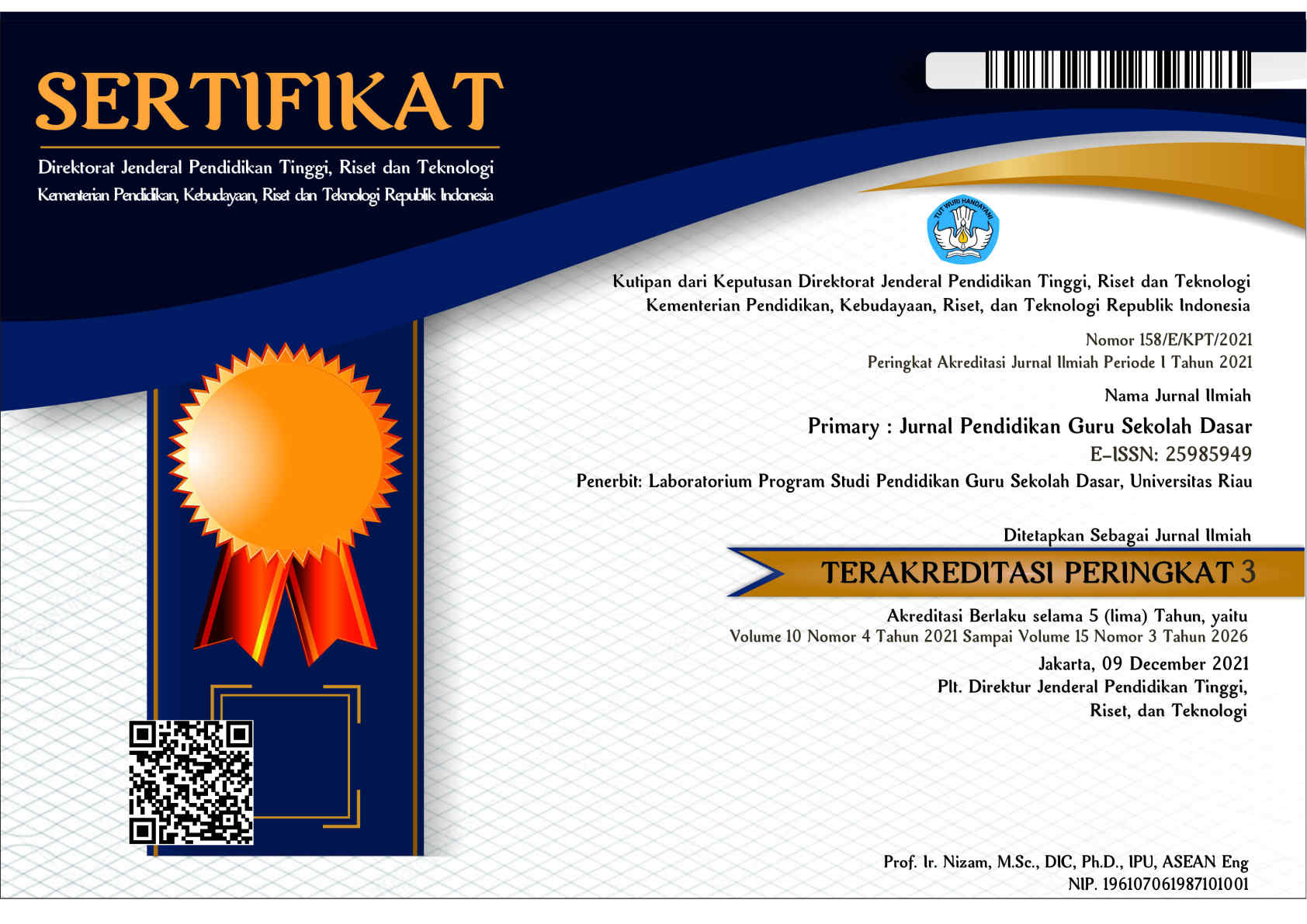INSTRUMENT VALIDITY FOR LEARNING RESOURCES ANALYSIS OF DIGITAL DISASTER FOR COASTAL AREAS: AN ANALYSIS OF AIKEN'S V
Abstract
This paper describes the instrument validity for digital learning resources for coastal areas based digital in the elementary school by using Aiken's V analysis. The purpose of the research is to develop an instrument that can be seen as the validity for every instrument item to obtain information about the need for digital-based coastal area disaster learning resources in elementary schools. The research approach uses a quantitative approach with a descriptive research method. Instrument design and validation were carried out in three stages; (a) literature review, (b) instrument draft design, and (c) qualitative and quantitative rater review of the instrument. Content validity is validated using the V Aikens coefficient. The content validity coefficient is measured by 8 raters based on the assessment results. It is assessed based on certain scales, which consisted of strongly agree (scale 4), agree (scale 3), disagree (scale 2), and strongly disagree (scale 1). The research results indicate that aspect 1, with four instrument items, is in the high category. For aspect 2, three instruments are in the high category. Aspect 3 with three instruments is in the moderate category. For aspect 4, two instruments are in the moderate category. Aspect 5 with three instruments is in the moderate category. In aspect 5, there are two high-category instrument items and three medium-category instrument items. It is concluded that out of the 22 items of needs analysis, in general, it was valid. Nevertheless, several instrument items needed to be reviewed, namely on the editorial aspect of the statement.
Keywords
Full Text:
PDFReferences
Afriana, I., & Festiyed. (2020). Meta-analysis of authentic assessment instrument development to measure learning outcomes of learners SMA/MA. Journal of Physics: Conference Series, 1481(1). https://doi.org/10.1088/1742-6596/1481/1/012052
Aiken, L. R. (1980). Content validity and reliability of single items or questionnaires. Educational and Psychological Measurement, 40(4), 955–959. https://doi.org/10.1177/001316448004000419
Aiken, L. R. (1985). Three Coefficients For Analyzing The Reliability And Validity Of Ratings. Educational and Psychological Measurement, 45, 131–141. https://journals.sagepub.com/doi/abs/10.1177/0013164485451012
Bashooir, K., & Supahar, S. (2018). Validitas dan Reliabilitas Instrumen Asesmen Kinerja Literasi Sains Pelajaran Fisika berbasis STEM. Jurnal Penelitian Dan Evaluasi Pendidikan, 22(2), 168–181. https://doi.org/10.21831/pep.v22i2.20270
Cor, M. K. (2016). Trust me, it is valid: Research validity in pharmacy education research. Currents in Pharmacy Teaching and Learning, 8(3), 391–400. https://doi.org/10.1016/j.cptl.2016.02.014
Gul, D. R., Ahmad, D. I., Tahir, D. T., & Ishfaq, D. U. (2022). Development and factor analysis of an instrument to measure service-learning management. Heliyon, 8(4), e09205. https://doi.org/10.1016/j.heliyon.2022.e09205
Hedden, M. K., Worthy, R., Akins, E., Slinger-Friedman, V., & Paul, R. C. (2017). Teaching Sustainability using an Active Learning Constructivist Approach: Discipline-Specific Case Studies in Higher Education. Sustainability (Switzerland), 9(8). https://doi.org/10.3390/su9081320
Istiyono, E., Mardapi, D., & Suparno, S. (2014). Pengembangan Tes Kemampuan Berpikir Tingkat Tinggi Fisika (PysTHOTS) Peserta Didik SMA. Jurnal Penelitian Dan Evaluasi Pendidikan, 18(1), 1–12. https://doi.org/10.21831/pep.v18i1.2120
Kalkbrenner, M. T. (2021). A Practical Guide to Instrument Development and Score Validation in the Social Sciences: The Measure Approach. Practical Assessment, Research, and Evaluation, 26, 1–18.
Kurniawati, K. (2021). Analisis Validitas Isi Instrumen Tes Berpikir Kritis IPS Kelas V SD Kota Yogyakarta. Pelita: Jurnal Penelitian Dan Karya Ilmiah, 21(1), 130–140.
Maryani, E. (2016). Model Pembelajaran Mitigasi Bencana dalam Ilmu Pengetahuan Sosial di Sekolah Menengah Pertama. Jurnal Geografi
Gea, 10(1). https://doi.org/10.17509/gea.v10i1.1664
Noviana, E., Kurniaman, O., Sb, N. S., Nirmala, S. D., & Dewi, R. S. (2021). How to Prepare Disaster Mitigation Knowledge for Prospective Teachers in Elementary School ? Al-Ishlah: Jurnal Pendidikan, 13(2), 1123–1134. https://doi.org/https://doi.org/10.35445/alishlah.v13i2.496
Pidie, M. A. N. (2019). Peningkatan Kompetensi Guru Melalui Pelatihan Pemanfaatan Teknologi sebagai Media Pendukung Pembelajaran di MAN 1 Pidie. Jurnal Sosiologi USK, 13(2), 167–183.
Prihono, E. W. (2019). Validitas Instrumen Kompetensi Profesional pada Penilaian Prestasi Kerja Guru Professional Competency Instrument Validity on The Assessment of Teacher Work Performance. Jurnal Penelitian Hukum Dan Pendidikan, 18(2), 897–910. http://jurnal.iain-bone.ac.id/index.php/ekspose
Ridwan, A. (2019). Persepsi Resiko Pencegahan Bencana dan Penampilan Guru SD dalam Mengurangi Dampak Bencana Gempa. JIM FKep, IV(2), 42–47.
Rusijono, R., Jaedun, A., Kartowagiran, B., Ahman, A., Laliyo, L. A. R., & Mam, S. (2020). Developing the teacher’s social competency assessment instrument in the fourth industrial revolution era. Jurnal Penelitian Dan Evaluasi Pendidikan, 24(2), 125–135. https://doi.org/10.21831/pep.v24i2.29482
Suarmika, P. E., & Utama, E. G. (2017). Pendidikan Mitigasi Bencana di Sekolah Dasar. Jurnal Pendidikan Dasar Indonesia, 2(2), 18–24.
Sugiharni, G. A. D., & Setiasih, N. W. (2018). Validitas dan Reliabilitas Instrumen Evaluasi Blended Learning Matakuliah Matematika Diskrit di STIKOM Bali Berbasis Model Alkin. IndoMath: Indonesia Mathematics Education, 1(2), 93. https://doi.org/10.30738/indomath.v1i2.2626
Suprapto, E., Saryanto, S., Sumiharsono, R., & Ramadhan, S. (2020). The Analysis of Instrument Quality to Measure the Students’ Higher Order Thinking Skill in Physics Learning. Journal of Turkish Science Education, 17(4), 520–527. https://doi.org/10.36681/tused.2020.42
Utomo, K. S., Muryani, C., & Nugraha, S. (2018). Kajian Kesiapsiagaan Terhadap Bencana Tsunami Di Kecamatan Puring Kabupaten Kebumen Tahun 2016. GeoEco, 4(1), 68–76. https://doi.org/10.20961/ge.v4i1.19180
Villafañe, S. M., Bailey, C. P., Loertscher, J., Minderhout, V., & Lewis, J. E. (2011). Development and analysis of an instrument to assess student understanding of foundational concepts before biochemistry coursework. Biochemistry and Molecular Biology Education, 39(2), 102–109. https://doi.org/10.1002/bmb.20464
Yuliarto, H. (2021). Analisis indeks aiken untuk mengukur validitas isi instrumen komitmen tugas bermain sepakbola. Jurnal Pendidikan Jasmani Indonesia, 17(1), 19–23.
Z, R. P., Sari, R., Jumadi, J., & Ariswan, A. (2020). Pengembangan dan Validasi Instrumen Tes untuk Mengukur Keterampilan Menyelesaikan Masalah Peserta Didik SMA pada Pelajaran Fisika. Jurnal Penelitian Pembelajaran Fisika, 11(1), 17–26. https://doi.org/10.26877/jp2f.v11i1.3993
DOI: http://dx.doi.org/10.33578/jpfkip.v12i1.9320
Refbacks
- There are currently no refbacks.
Copyright (c) 2023 Eddy Noviana, S.Pd., M.Pd (Scopus ID: 57211855166), Intan Kartika Sari, Zufriady Zufriady, Sri Erlinda

This work is licensed under a Creative Commons Attribution-NonCommercial-ShareAlike 4.0 International License.
____________________________________________________________
Primary: Jurnal Pendidikan Guru Sekolah Dasar
Secretariat
Program Studi Pendidikan Guru Sekolah Dasar
Gedung B1, FKIP Universitas Riau
Kampus Bina Widya Km. 12,5 Simpang Baru Panam
Pekanbaru Riau Indonesia 28293
e-mail : primary@ejournal.unri.ac.id



